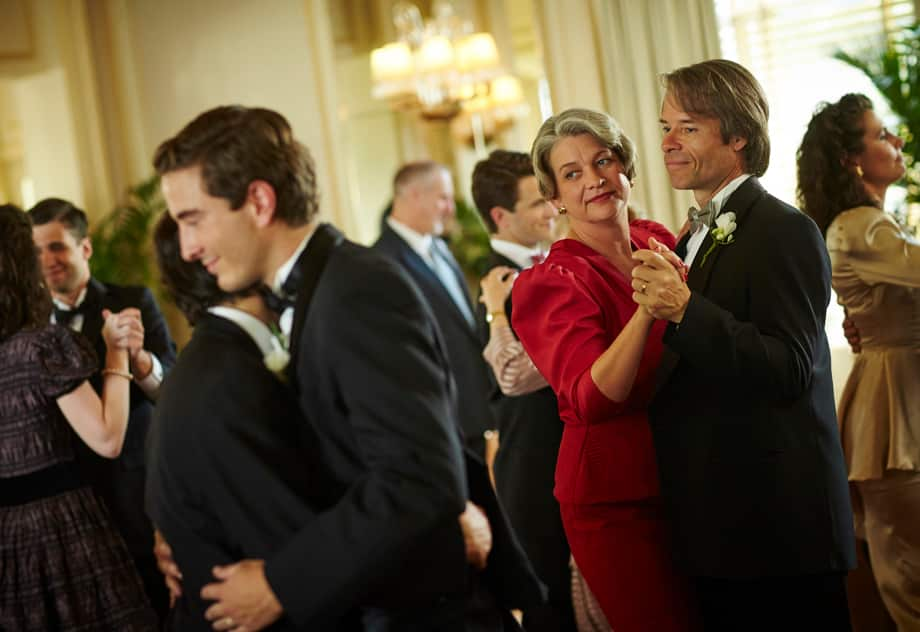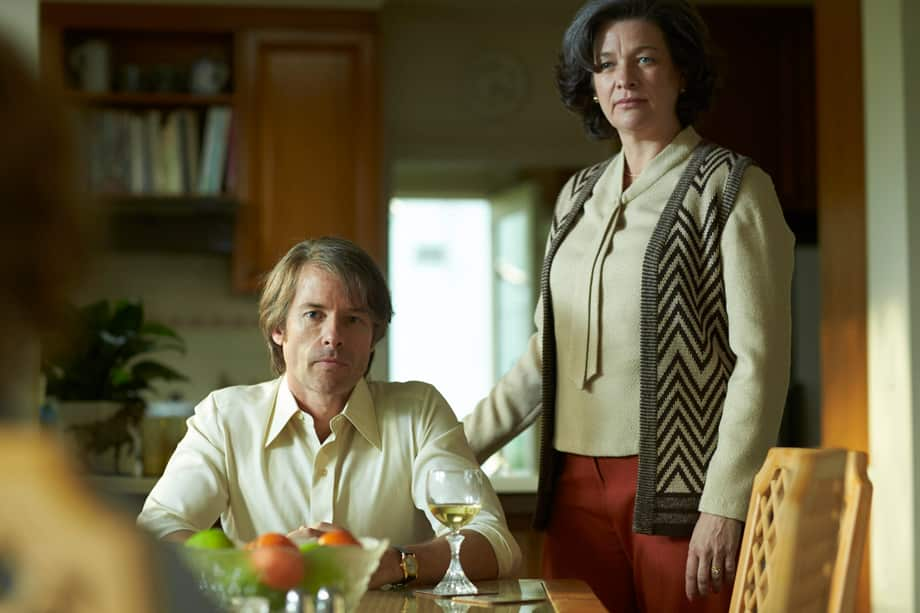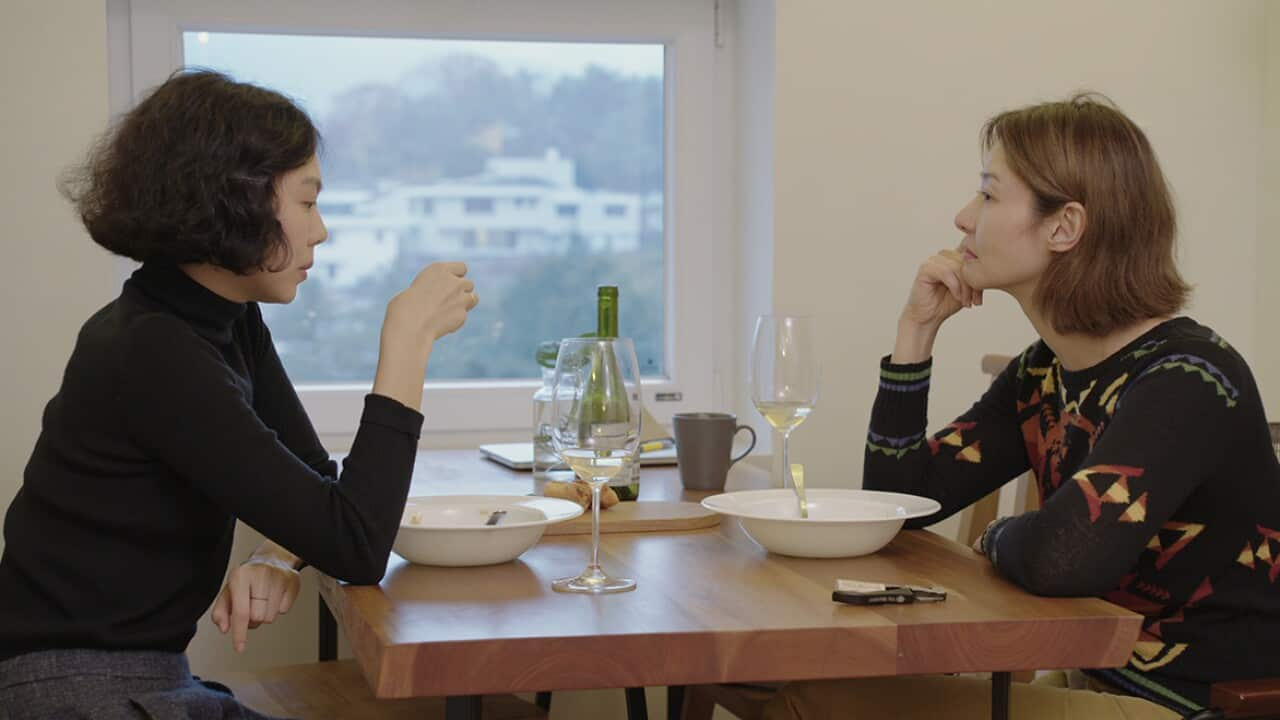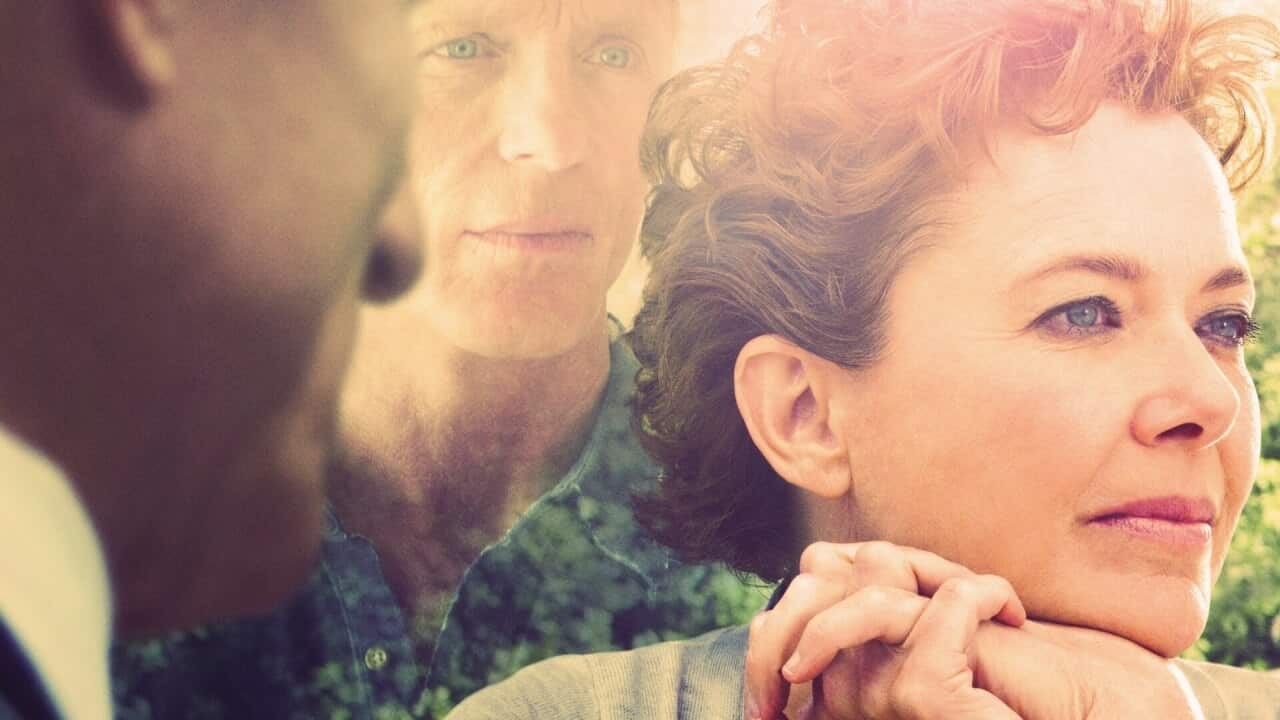This article was first published in 2015 for the cinema release of Holding The Man. The film will screen on SBS VICELAND, Monday 12 February 2018 (scroll down for full details).
Tim Conigrave’s relationship with John Caleo began with a burning crush in high school, when the wannabe actor fell hard for the captain of the football team. A bold phone call confirmed for Tim that the feeling was indeed mutual, and together, the star-crossed lovers went on to endure a deep family rift, infidelity, and a shared diagnosis of AIDS in the ‘80s. Tim recalled his love for the beautiful boy with the big eyelashes in a vibrant memoir, Holding The Man, which he wrote on his deathbed (and which was published posthumously).
20 years after the original memoir, director Neil Armfield () brings the story to life, in the terrific Holding The Man (adapted by Tommy Murphy, who had penned the eponymous 2006 stage play). Ryan Corr and Craig Stott play the raunchy lovebirds with gusto, and their chemistry conveys the spark that sustains Tim and John through their rollercoaster 15 years.
Holding The Man enjoyed a rapturous world premiere as the closing night film of the 2015 Sydney Film Festival (where it overcome an early glitch that projected the film’s first few scenes with a bright pink overlay – but more on that later). It met with similar raves just weeks later at the Melbourne International Film Festival.
Holding The Man is being released into cinemas at an odd moment in Australian history. When I spoke to Neil Armfield, the day’s headlines were dominated with news of the Federal Coalition’s having rejected a conscience vote on redefining marriage to include same-sex couples. It made for an interesting segue to talk about a 30 year-old love story that could well have been written today. For a film set in the ‘70s and ‘80s it’s uncanny how relevant it is right now...
For a film set in the ‘70s and ‘80s it’s uncanny how relevant it is right now...

Director Neil Armfield. Source: AAP
It’s a huge irony really, but it’s also an irony that Tim was an activist who probably would have been against the bourgeois institution of marriage, I have to say. It was a much more radical sense of gay rights and rights for people with HIV that Tim was an activist for. However, the fact that this is now really a human rights issue means that I think it’s completely appropriate for the meaning of this story to resonate within our culture as much as it is and for it to be used as great kind of flag in this debate.
Everyone knows someone who is gay and that’s the reason that that 70% of the nation feels that this is just not an issue! Why is it that the politicians seem to be so kind of squeamish? It just seems insane. The Liberal party looks absolutely ridiculous. The prime minister looks ridiculous. But there is this kind of extraordinary alignment in the stars…
I mean, you look back at that very first screening at the Sydney Film Festival, when the projectors projected the film pink. In the late ‘70s Tim Conigrave was part of a theatre company that was called the Pink Theatre Company! The projectionists have no rational explanation for why the projectors would have dropped out the blue and the yellow of the three colour digital projector. They said it’s never done it before, there was no setting that was touched. It was Tim! That was Tim having a joke, laughing at the whole thing.
And for it to be that shade of Pink too; it was regulation pink flag pink…
Exactly. That’s the kind of pink it is! So I had the great pleasure of screaming out, [dramatic pause] “Stop the film!” [Laughs]
The movie’s tagline is, ‘A love story for everybody’. That’s a clear pitch to a broad audience.
We’d like everyone to see it. The book has been so significant and the reason it is so loved is that it’s been a crucial work for kids who are in a difficult situation with their identity. But it clearly crosses boundaries very easily, beyond gay identity, for young kids who are questioning themselves, or being questioned by others. For kids who know something about themselves but are feeling bullying or pressure from others, whether it’s family, or church or school. It’s like water to someone dying of thirst really; it’s so clear, and funny and pure. And it comes from the heart. Its detail is so true. Tim kept himself alive in order to get this book down. And the book is a monument not only to their love – but a kind of a future which he hoped one day might exist.
What was that like for you? To shoulder the responsibility to do the right thing by Tim and John’s memory, and to the people who remain?
It’s a responsibility that you carry all the time. I wrote to both families when we first had the rights. Obviously the Conigrave family hold the rights to the book and they’re extremely proud of Tim. I think the Caleo family has a very different relationship to it. In many ways Bob Caleo is the antagonist of the story, he represents a kind of a force of disapproval and someone who would stop this relationship if he could. Mr Caleo is still alive. I think Anthony LaPaglia’s performance very truthfully acknowledges that every position that John’s father has, comes from a place of love. It’s full of the sense of tragic pain that is very much wrestled with in the story, and it’s a really important part of the story’s texture. You sense that this father is a very religious man, and he’s doing what he thinks is important and that he’s being true to his own upbringing and his own hopes for the family. There’s no doubt that he is acting out of love. I loved being able to explore that. There’s a moment when John first leaves the house and Bob closes the front screen door, and you just see him behind bars, really. There’s something very tragic for that man about that. I had a realisation during the edit that this was a story about a kind of love triangle between Tim and John and Bob, in a way, and it was like there was a competition between the two different kinds of love: the love of a father for his son, and the love of a man for the man he loved. That’s a really interesting way of thinking about it. Once it moves towards the last third of the film and Bob is there in the hospital and wanting to bring John home to Melbourne, that’s the classic energy of that relationship.
I had a realisation during the edit that this was a story about a kind of love triangle between Tim and John and Bob, in a way, and it was like there was a competition between the two different kinds of love: the love of a father for his son, and the love of a man for the man he loved. That’s a really interesting way of thinking about it. Once it moves towards the last third of the film and Bob is there in the hospital and wanting to bring John home to Melbourne, that’s the classic energy of that relationship.

Bob Caleo (Anthony LaPaglia) discovers that his son is gay when he finds a love letter, in a scene from Holding The Man (2015). Source: Transmission
The tone is so important – as with any film, of course - but here, you’ve got to get the balance right to convey the gravity, but equally to capture the lighter moments.
Oh absolutely…
…And of course, to give a sense of the heat between the two of them.
[Laughs] ‘The heat’! Yes, the ‘heat’ is very important…
It is! It’s really lusty! It’s great.
[Laughs] You know, it’s a fact that Tim was such a funny guy, really. You can tell from the book how funny he was. And you meet Tim’s mother now and she’s such a funny woman. She had such funny things to say about [Laughs] the sex in the film. She said when she reads the book she skims over those bits and she urged me not to dwell on it in the film...! The first time she saw the film she said she had her hands over her face, but each time she watches it, her hands widen a little bit and she’s quite enjoying it now…!
Well, there you go. There’s no higher praise.
Yep!
And then, the scene where Tim loses John. It’s beautifully balanced and realistic, to mix laughter with tears…
Thank you. Yes, in facing the most extreme moment of mortality they’re able to be funny with each other, but that’s really just true. It’s what it’s like.
Exactly. We’ve all been there… And while we’re on the film’s biographical elements, how much were you able to park that to one side, and just focus on making a good movie?
The real life story? I don’t know if we ever completely parked it. We were filming in Melbourne, so there were a lot of people who were very close friends with Tim who were actors – of course, Tim was an actor – who are in the film: Kaarin Fairfax (who sings at Tim’s sister’s wedding) lived with Tim, acted with Tim, loved Tim; Julie Forsyth who plays Tim’s Aunty Gae (the one who says, “We loved your dog food commercial, Timothy”) was in the Monash theatre group with Tim; Paul Goddard, who plays the priest at John’s funeral, has that great line in trying to negotiate the terms of what his eulogy is going to be, and he’s like this shifty guy doing a deal out on the lawn - until Tim lets him have it. Paul was one of Tim’s closest friends at NIDA. Many of the extras in the wedding scene were very, very close friends of Tim: some of them were in Romeo and Juliet with him – the play that’s depicted at the front; Tim’s mum and his sister and his niece are sitting there in one shot, when Guy Pearce gets Tim up to dance… [for the buffs: Tim’s mum is pictured in the background of that scene. She's the woman in fuchsia pink with white hair, watching on].
Many of the extras in the wedding scene were very, very close friends of Tim: some of them were in Romeo and Juliet with him – the play that’s depicted at the front; Tim’s mum and his sister and his niece are sitting there in one shot, when Guy Pearce gets Tim up to dance… [for the buffs: Tim’s mum is pictured in the background of that scene. She's the woman in fuchsia pink with white hair, watching on].

Pictured from left: Craig Stott (obscured), Ryan Corr, Kerry Fox and Guy Pearce, in a scene from Holding The Man (2015) Source: Transmission Films
We were at Xavier College, where the ghosts of Tim and John are very much around that place, and also ACON here in Sydney and the Victorian AIDS Council supported the film. Tim worked for ACON (when it was the AIDS Council of NSW), he was an AIDS activist. There were many members of the gay community and people with HIV and some people who were very, very sick, who wanted to be extras in the film, who are in there.
So really on every day of filming we were dealing with people for whom the story was more than a story, so we never parked it. That said, you know, Tommy and I dealt with the fact that we had to find something that was satisfying, had tension, and grew properly as a story, as a story. It’s just a miracle that the more we cut away, the stronger the bones of that story are, structurally, but it’s all true, really.
And I believe the phone used for that fateful call, was the phone?
[Laughs] Ah, yes. That was Anna, Tim’s sister, who now lives in Adelaide. She’d taken the family phone – it’s a beautiful ’70s rotary PVC telephone, in that fabulous green. She’d taken it to Adelaide and brought it back at the beginning of filming – on her lap in the plane – and gave it to us to use as a prop, even though the connecting wire has started to pull out of the handpiece. We had another phone that was actually identical, and Dean, who was in charge of props, asked ‘Do you want me to swap it for one that’s properly plugged up?’ In other words, one that doesn’t look like it’s going to fall apart. I said, ‘No, we have to use this phone’, because that was the phone that Tim used when he went into his parents’ bedroom and called John to say, ‘Will you go round with me?’ and started the whole thing off. And what an extraordinary thing to do.
Yes, such a gutsy, romantic move.
Obviously with the casting, you’ve got to get Tim and John right.
It’s easier said than done, and it’s a thing that I was terrified of. Casting is always terrifying because it’s at least 60% of your job. More, more – it’s more like 80%. If the energy wasn’t right between Ryan and Craig then there’s no film.
There’s a beautiful little image of Tim and John – a photo from about 1978, I think – of them both in a caravan park. They’re on green grass, in their swimmers. Tim’s looking up at the camera with John cuddled in beside him, both with fabulous ‘70s hair. Tim’s slightly quizzical – slightly. There’s something a little bit sad in those eyes, but also quite, ‘This is who I am’, looking up into the camera. John has a loving tenderness about him. John was smaller than Tim. Even though it wasn’t particularly important to get a physical likeness between the actors and the real characters, there’s something built into their bodies, into their faces, that you could see the story making sense. That little picture was sort of a talisman for me. I kept on staring at it, when I was casting, to feel what the energy was between those two guys. I certainly felt that with Ryan and Craig when I finally got them together.
Ryan appeared very, very early in the process of audition. His was one of the first screen tests we looked at and I said to Tommy, “I think he could do it”. Craig took a very, very long time to find, actually. Craig, particularly as a person, is nothing like John. Although physically he does have similarities: he is very beautiful and he’s got the eyelashes! I guess you could say I’d dismissed Craig – he’d sent a self-test across from LA and I‘d looked at it very early and hadn’t shortlisted him, and so he dropped off the list and I’d forgotten about his test. Much later I was in LA and my friend Richard Barrett, the Australian playwright said, “Have you seen Craig Stott?” I said, “No..”. He said “Well, you should. He’s really good, and he’s got the eyelashes.” [Laughs]. So I got Craig in just before I got on a plane and at very short notice. Anthony LaPaglia was around so he came in and tested with him. After the test, I said to Anthony, “Well, he was really good but I’m not sure he’s going to get it.” Anthony just looked at me and said, “Why not?!”
I guess you could say I’d dismissed Craig – he’d sent a self-test across from LA and I‘d looked at it very early and hadn’t shortlisted him, and so he dropped off the list and I’d forgotten about his test. Much later I was in LA and my friend Richard Barrett, the Australian playwright said, “Have you seen Craig Stott?” I said, “No..”. He said “Well, you should. He’s really good, and he’s got the eyelashes.” [Laughs]. So I got Craig in just before I got on a plane and at very short notice. Anthony LaPaglia was around so he came in and tested with him. After the test, I said to Anthony, “Well, he was really good but I’m not sure he’s going to get it.” Anthony just looked at me and said, “Why not?!”

John Caleo (Craig Stott) is the captain of the football team at Xavier College in Holding The Man (2015). Source: Transmission
And speaking of Anthony, you have a number of big actors in supporting roles.
Anthony was the first person we cast. It just seemed that he is absolutely centre of the field for Bob Caleo. The Italianness and the age, and the dignity that Anthony brings were all correct and something very formidable and deep within him. Anthony read it and just committed immediately.
For the parents [Kerry Fox and Guy Pearce as the Conigraves and LaPaglia and Camilla Ah Kin as the Caleos], they’re two such different relationships. We had to get the sense of variety in the story of the difference between the families. Romeo and Juliet is the guiding principle of the show. It’s a miracle that Tim was in Romeo and Juliet. At Xavier he was the drama boy – in a minor part! That gave us great images for the opening but also a great thematic link to the actual story of Tim and John.
Romeo and Juliet is the guiding principle of the show. It’s a miracle that Tim was in Romeo and Juliet. At Xavier he was the drama boy – in a minor part! That gave us great images for the opening but also a great thematic link to the actual story of Tim and John.

Dick Conigrave (Guy Pearce) and Mary Gert-Conigrave (Kerry Fox) look on as their son Tim comes out to them, in Holding The Man (2015) Source: Transmission
Romeo and Juliet starts with the line, ‘Two households, both alike in dignity’ and finding the difference in personality between those two households was so important. Clearly it’s Mary who’s the stronger, defining personality of the Conigrave household, whereas in the Caleo household it’s Bob who creates the energy of that house. Generating the energy of the two households gave us an interesting contrast of canvases to put behind the two boys.
Patrick Abboud interviews screenwriter Tommy Murphy
Watch 'Holding the Man'
Saturday 5 March, 9:30pm on SBS World Movies / Streaming after at SBS On Demand
M, CC
Australia, 2015
Genre: Drama
Language: English
Director: Neil Armfield
Starring: Anthony LaPaglia, Ryan Corr, Sarah Snook, Guy Pearce, Craig Stott

Source: SBS Movies







